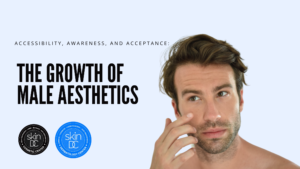It is a common misconception that cosmetic treatments are solely meant for women. In the last few years, an increase in the number of men getting aesthetic treatments, including toxin injections, fillers, and hair restoration, indicates a huge market potential for male aesthetics. Although men remain a minority compared to women in the industry, the market growth of male aesthetics is currently keeping pace with growth of the female market.
The doctors at SkinDC suggest that awareness may be the biggest obstacle preventing male aesthetics from being as socially accepted as female aesthetics. With the aesthetic medical industry having been mainly marketed to women, men are less likely to be aware of the breadth – and acceptability – of the treatments available to them. As a result of being historically geared towards women, there is a common viewpoint that aesthetic treatments serve to increase femininity and beauty. This is flawed, as treatments can be used to address different aesthetic concerns among both men and women. The top three cosmetic concerns we see in men are hair loss and age-related changes to the jawline and periocular areas. Injections with neurotoxins and dermal fillers can reduce tired and aged appearance without the feminization of facial features. Body contouring can also help men achieve desired body goals.
Every cosmetic treatment/procedure is available to women and men. The first step is getting male patients into the office so the doctors can educate them and provide them the opportunity to consider available options. At SkinDC, our board-certified dermatologists and facial plastic surgeon create unique and individualized treatment plans that cater to the needs and desires of the patient while giving natural yet effective results.
Another large component in the growth of male aesthetics is accessibility. It has only been until recently that the stigma surrounding female aesthetic treatments and procedures has been reduced. With education and awareness perpetuated through social media and marketing, treatments are more accessible than ever. With greater accessibility often comes greater affordability. Treatments that were once considered prohibitively expensive and unnatural to many individuals are now seen as a staple. There is greater acceptance as the industry has grown, techniques have improved, and more options have become available. Similarly to the growth and acceptance of the female aesthetic market, the male aesthetic market seems to be following that pattern.
What was once thought to be out of reach for many women has now become within reach for many men. As the accessibility and acceptance of male aesthetics continue to grow, so does the market. Every person, regardless of their gender, deserves to feel confident. Aesthetic medical treatments allow for this confidence to be achieved without sacrificing masculinity.


